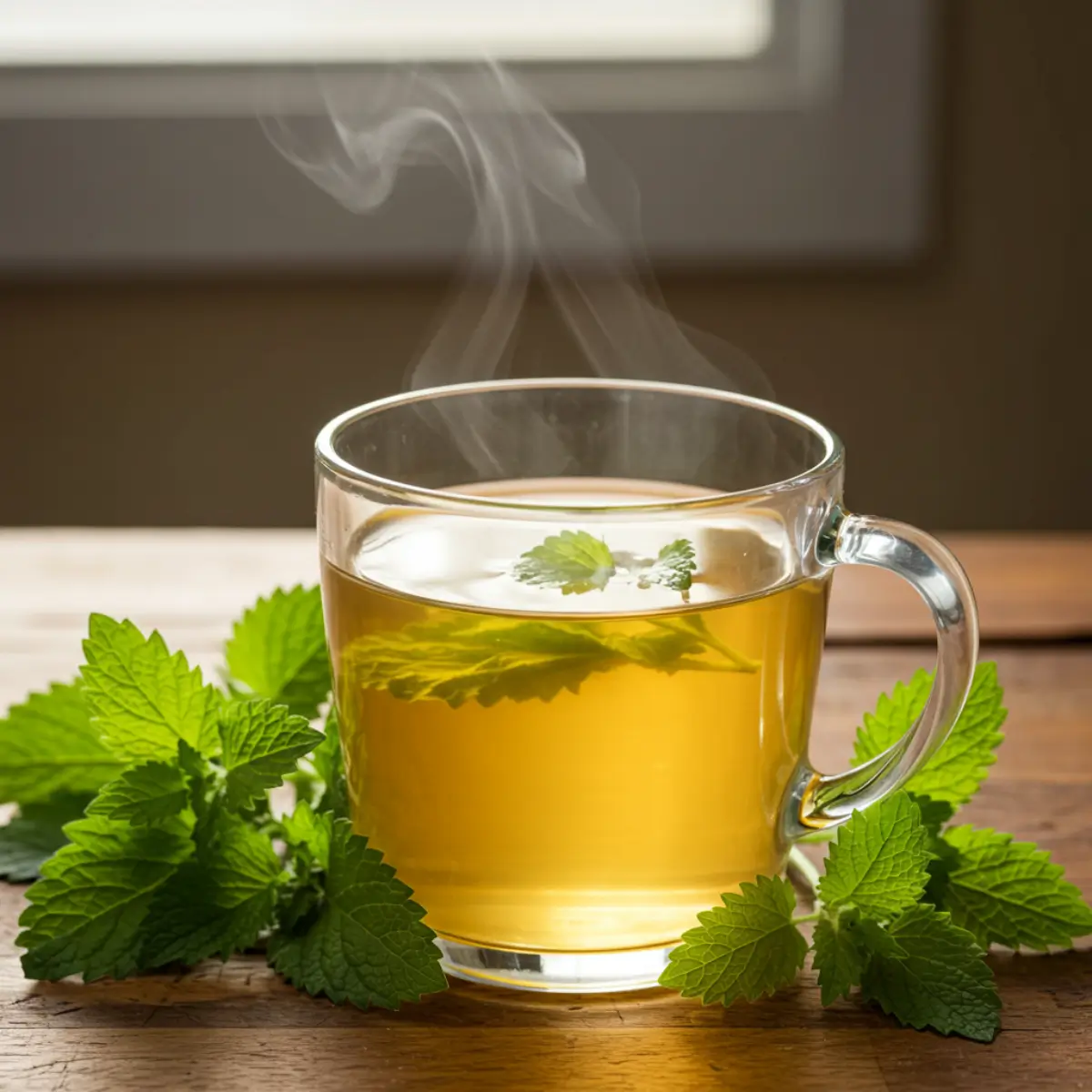Lemon balm tea recipe lovers, this one’s close to my heart. The first time I brewed lemon balm straight from my garden, it was a chaotic morning with three hungry toddlers and zero peace. One sip of that gentle, citrus-scented tea, and everything softened. There’s something incredibly calming about lemon balm. Over time, it became my go-to herbal ritual—not just for stress relief but also for gentle detox and weight balance. This lemon balm tea recipe is perfect for quiet mornings or chilled over ice in summer. Whether you’re brewing for wellness or flavor, you’re in for something special.
Table of Contents
Lemon Balm Tea Recipe: More Than Just a Soothing Herbal Drink
Lemon balm tea recipe benefits you’ll feel from the first cup
Lemon balm tea Recipe isn’t just another herbal remedy—it’s a centuries-old recipe that soothes digestion, calms nerves, and supports weight balance naturally. In ancient traditions, lemon balm was brewed to reduce stress and uplift the mood. But in today’s fast-paced world, its calming effects feel more essential than ever. One of the reasons I love this lemon balm tea recipe is because it brings me back to balance—especially during stressful weeks. Plus, it’s caffeine-free, so you can sip it day or night.
If your goal is to gently support weight management, lemon balm tea works in your favor by lowering cortisol (a stress hormone tied to weight gain). This is what makes it more effective when paired with other natural remedies like my himalayan salt weight loss recipe or a light detox blend like papaya and lemon juice. The result is subtle, consistent support for your body’s rhythm and needs.
Lemon balm iced tea recipe: summer’s best detox drink
When the heat rolls in, I make this same lemon balm tea recipe but cool it down for a revitalizing iced version. It’s one of the easiest herbal drinks to make refreshing and still retain its wellness properties. For a lemon balm iced tea recipe that helps with weight loss, I often add a few slices of cucumber or a splash of fresh lemon. This combination boosts hydration and offers a gentle detox effect—no harsh cleanses required.
Internal tip? Mix this with a chilled bottle of blue spirulina coconut water for a mineral-rich superdrink. The combination supports skin glow and cellular recovery after workouts. Whether you’re sipping hot or cold, lemon balm tea remains a staple in mindful wellness.
Print
Lemon Balm Tea Recipe
- Prep Time: 2 minutes
- Cook Time: 5 minutes
- Total Time: 7 minutes
- Yield: 1 cup
- Category: Herbal Tea
- Method: Steeped
- Cuisine: Natural Wellness
Description
A calming and gently detoxifying lemon balm tea recipe that supports digestion, reduces stress, and helps with weight balance.
Ingredients
- 1 tsp dried lemon balm or 1 tbsp fresh
- 1 cup hot water (not boiling)
- Optional: Lemon slice
- Optional: Mint or ginger
- Optional: Honey (for taste)
Instructions
- Add lemon balm to a teacup or infuser.
- Pour hot water over the leaves.
- Steep for 5–7 minutes.
- Strain and serve warm or over ice.
- Add optional lemon, mint, or ginger.
Notes
- For iced tea, double the amount of lemon balm and chill after straining.
- Drink 1–2 cups daily for wellness support.
- Avoid mixing with caffeine or sedatives.
How to Make a Lemon Balm Tea Recipe That Supports Wellness
Lemon balm tea recipe steps you can master in minutes
Making a lemon balm tea recipe at home couldn’t be easier. All you need are fresh or dried lemon balm leaves, hot water, and about five minutes. I usually gather mine straight from the garden, rinse them gently, and crush them slightly to release the oils. If you’re using dried lemon balm, a teaspoon per cup works beautifully. Simply pour just-boiled water over the leaves and let it steep for 5–7 minutes. Strain and sip. That’s it—simple, restorative, and nourishing.
When I want a deeper calming effect, especially on anxious or busy days, I add a pinch of dried chamomile or lavender. It turns the tea into a bedtime elixir. If you’re planning to drink it chilled, make a double batch, steep it strong, and let it cool completely before refrigerating. Add lemon slices or mint for that perfect lemon balm iced tea recipe flavor. And if you’re prepping this for post-meal digestion, a touch of grated ginger adds a warming finish.
This is one of my favorite rituals. While the tea steeps, I like to pause, breathe, and take those few quiet minutes just for myself—before the next wave of mom life hits. It’s that kind of grounding moment this recipe gives me, again and again.
Lemon balm tea recipe for weight loss that fits real life
Now let’s talk about weight loss, because many people ask me if lemon balm really helps. The answer is yes—but gently. A lemon balm tea recipe for weight loss works best as part of your daily rhythm. Lemon balm naturally supports digestion, helps reduce bloating, and lowers stress-induced cravings. It doesn’t act as a harsh diuretic or stimulant. That’s what I love about it—it supports the body instead of pushing it.
To amplify the benefits, I like combining it with other natural allies. For example, pairing this tea with a light evening meal that includes my guruko furidamu herb benefits or sipping it alongside a detoxifying green blend in the morning sets the tone for balanced wellness. Lemon balm iced tea, especially with fresh lemon and cucumber, becomes your secret summer weight support drink. It keeps your hydration up while reducing the urge to snack.

Here’s a simple variation for weight balance:
| Ingredient | Purpose |
|---|---|
| Lemon balm (1 tsp dried or 1 tbsp fresh) | Base herb for calming, digestion |
| Lemon slice | Boosts detox and flavor |
| Cucumber slice | Reduces bloating, cools the body |
| Ginger slice | Stimulates metabolism gently |
That’s a recipe I return to often. It tastes delicious, feels nourishing, and doesn’t require anything fancy or artificial. And the best part? Your body actually craves it once you make it a habit.
Lemon Balm Iced Tea Recipe for Weight Loss and Hydration
Lemon balm iced tea recipe that cools, calms, and restores
When the Texas sun is high and the house is buzzing with energy (and toddlers), nothing resets my body quite like this lemon balm iced tea recipe. It’s cooling, naturally sweet, and hydrating. Plus, it still carries all the wellness benefits of the hot tea version, but in a format that feels like a treat. This is how I stay refreshed, especially during the warmer months.
To make a perfect lemon balm iced tea, steep double the amount of lemon balm leaves—about 2 teaspoons dried or 2 tablespoons fresh per cup—in just-boiled water for 10 minutes. Then strain, cool, and refrigerate. For extra flavor and function, add lemon slices, cucumber, or even a touch of raw honey (if you’re not watching sugar closely). I often make a large pitcher in the morning and keep it chilled throughout the day.
You can also toss in a few blue spirulina coconut cubes for a splash of color and a hit of minerals. They melt into the tea, giving it a dreamy turquoise swirl—and more than a few compliments from guests.
Whether I’m sipping this iced tea solo on the porch or sharing it with friends at a weekend gathering, it always feels like a gift to the body.
Making lemon balm iced tea recipe for weight loss work every day
A lemon balm tea recipe for weight loss doesn’t have to be complicated or boring. It’s really about simple habits that build results over time. I often enjoy a chilled glass mid-morning instead of a second cup of coffee—it keeps my digestion smooth and my energy stable without the crash. One of the reasons this lemon balm tea recipe works so well is because lemon balm contains rosmarinic acid, a natural compound known to help lower cortisol levels. Less cortisol means fewer stress-driven cravings and better metabolic balance.
To make the lemon balm tea recipe even more weight-friendly, I like to add a slice of fresh ginger and a sprig of mint. Mint gently curbs appetite and aids digestion, while ginger gives a subtle thermogenic lift. On weeks when I’m more focused on shedding a little bloat, I pair this tea with my himalayan salt weight loss recipe or follow it with a light, cleansing tonic like my papaya and lemon juice recipe. These combinations make weight support feel nourishing—not restrictive.
Here’s how I rotate it into my day:
| Time of Day | How I Use Lemon Balm Tea |
|---|---|
| Morning (fasted) | Hot version to wake up digestion gently |
| Mid-morning | Iced tea with lemon/cucumber to hydrate and energize |
| Afternoon | Calm the nervous system and curb sweet cravings |
| Evening | Warm lemon balm tea with chamomile for relaxation |
You don’t need to make drastic changes. This iced lemon balm tea recipe is about showing up for your body in consistent, gentle ways. And over time, that’s where real transformation happens.
Lemon Balm Tea Recipe Variations for Calm, Immunity & Hormone Support
Lemon balm tea recipe variations that bring balance to your day
What I love most about the lemon balm tea recipe is its flexibility. You can adjust it for the season, your energy level, or even your mood. While the basic recipe is soothing on its own, adding other herbs can deepen its benefits. As someone who uses herbal blends to help with sleep, digestion, and hormonal balance, lemon balm has become one of my staple ingredients.
For hormonal balance, especially around PMS or perimenopause, I often mix lemon balm with dried raspberry leaf and nettle. This blend supports adrenal health, calms emotional swings, and nourishes the nervous system. If you’re struggling with irritability or poor sleep, it’s incredibly grounding. For immune support, especially in the colder months, I’ll steep lemon balm with elderflower or a cinnamon stick. The result is both warming and protective—perfect for those days when you feel a tickle in your throat or your body just says “slow down.”
And yes, this same tea base still supports weight balance. When your stress hormones are steady, and your digestion is supported, your metabolism naturally finds its rhythm. You’re not forcing the body—you’re supporting it, cup by cup.
Lemon balm tea recipe with modern and ancient herbal pairings
My kitchen is often filled with little jars of dried herbs from the garden or the market—ginger, holy basil, fennel, and hibiscus. Over time, I’ve created favorite blends that start with the basic lemon balm tea recipe and evolve based on what my body needs.
If I’m feeling anxious or overextended, I pair lemon balm with holy basil (tulsi), a powerful adaptogen that calms the mind and boosts focus. For gut balance and gentle detox, fennel and lemon balm are a dream together—light, refreshing, and ideal after meals. On hot afternoons, I reach for hibiscus and lemon balm, served over ice. It’s tart, floral, and deeply hydrating.
Want something that soothes and uplifts at the same time? Try blending lemon balm with dried orange peel and a splash of raw honey. It becomes a natural “comfort tea” you can enjoy anytime—like a warm hug in a mug.
Here’s a quick comparison of wellness variations:
| Variation | Paired Herb | Benefit |
|---|---|---|
| Hormone Support | Raspberry Leaf + Nettle | Balances mood, nourishes adrenals |
| Immune Support | Elderflower + Cinnamon | Warming and protective |
| Digestive Calm | Fennel | Eases bloating, supports gut health |
| Stress Relief | Holy Basil | Calms nerves, supports clarity |
| Mood Boost | Orange Peel + Honey | Lifts spirits, naturally sweet |
Every time I brew a new version of this tea, I feel connected—to the earth, to my body, and to something far older than me. That’s the heart of every lemon balm tea recipe I create. It’s not just a drink—it’s a ritual that roots me, and it can root you, too.
Lemon Balm Tea Recipe Best Practices, Storage & Troubleshooting
Lemon balm tea recipe troubleshooting: getting the best taste and results
If your first try with a lemon balm tea recipe doesn’t taste quite right—don’t worry. You’re not doing it wrong. Lemon balm is gentle, but it can be a little picky when it comes to temperature and steeping time. Too hot and it tastes grassy. Too long and it can get bitter. The sweet spot? Use just-boiled water that’s cooled for about 30 seconds, and steep for 5–7 minutes max.
If your tea feels too bland, try adding more lemon balm next time, especially if you’re using fresh leaves (they’re milder than dried). You can also muddle the fresh leaves slightly with the back of a spoon before steeping. That little bit of pressure helps release the oils and gives you a fuller flavor. A splash of lemon or a slice of ginger not only improves the taste but enhances the health benefits too.
For those who are caffeine-sensitive or looking for a bedtime option, avoid mixing lemon balm with green or black tea, as these will introduce stimulants and may counter the calming effects. If you’re blending it for sleep or hormonal support, stay with herbs like chamomile, lavender, or raspberry leaf instead. And if you’re already using calming medications, check with your practitioner—lemon balm is gentle, but it can amplify sedative effects.
How to store lemon balm tea and leaves for maximum freshness
Storing your lemon balm correctly makes all the difference. If you grow your own, harvest it mid-morning once the dew has dried but before the midday sun hits—the oils are strongest then. Lay the leaves flat to dry in a cool, dark area with airflow. Once completely dry, store them in an airtight glass jar away from light and heat. They’ll keep their flavor and potency for up to 6–9 months.
For ready-made tea blends, keep them sealed and dry. Don’t refrigerate loose tea—it can absorb moisture and lose its aroma quickly. If you’ve brewed a large batch of iced lemon balm tea, store it in the fridge in a glass pitcher with a lid. It stays fresh for up to 3 days. I like to add fresh lemon slices and mint after chilling so they don’t overpower the tea as it sits.
Need to travel with your tea? I pack a small jar of dried lemon balm or pre-make tea bags using organic cotton sachets. That way, I never miss my daily wellness routine, even on road trips.
If you’re layering lemon balm into a broader wellness plan, pair it weekly with my guruko furidamo tea recipe or alternate it with hydrating options like blue spirulina coconut water to keep your body nourished, mineral-rich, and balanced.
The beauty of a lemon balm tea recipe is its adaptability. Whether you’re steeping a hot cup to wind down or mixing a vibrant iced blend to energize your afternoon, there’s always a way to make it suit your lifestyle and goals.
Lemon balm tea recipe myths you shouldn’t believe
Like many herbal drinks, the lemon balm tea recipe has its fair share of myths. One of the most common? That it works like a fast fat-burner. The truth is, lemon balm supports weight loss indirectly—by calming stress, reducing bloating, and helping your body digest and rest better. It’s not a magic pill, and it shouldn’t be treated like one. When paired with real, nourishing foods and gentle movement, that’s when the results show up.
Another myth is that more is better. In reality, drinking too much lemon balm tea can lead to sluggishness or interact with certain medications. A balanced intake—1 to 2 cups per day—is ideal for most people. This is where mindful wellness matters. Just like I approach my guruko furidamu herb benefits or himalayan salt weight loss recipes, it’s about small, supportive actions that build long-term results.
FAQs
How do you make tea with lemon balm?
To make lemon balm tea, steep 1 teaspoon of dried leaves (or 1 tablespoon fresh) in just-boiled water for 5–7 minutes. Strain and sip. For iced versions, double the amount and chill after steeping.
Can I drink lemon balm tea every day?
Yes, you can enjoy a cup or two daily. It’s caffeine-free and safe for most people. However, if you’re pregnant, nursing, or on medication, check with your practitioner first.
What not to mix with lemon balm tea?
Avoid combining it with strong sedatives or stimulants like caffeine. Lemon balm may amplify drowsiness if you’re on calming meds. Stick with herbs like chamomile, mint, or tulsi for safe pairings.
Can lemon balm tea help with weight loss?
Yes, indirectly. Lemon balm supports digestion, reduces stress-related cravings, and promotes relaxation. All of these can aid healthy weight balance over time, especially when combined with mindful eating and hydration.
Conclusion
A well-crafted lemon balm tea recipe is more than a soothing herbal drink—it’s a ritual for balance, digestion, and weight support. Whether you enjoy it warm to wind down or chilled for a refreshing detox, this tea has a timeless place in daily wellness. Its calming effect on the nervous system and natural support for metabolism make it a smart, gentle ally for anyone seeking sustainable health.
From my home in Texas to your cup, this recipe has been a quiet anchor in my routine—and I hope it becomes one in yours too. Keep it simple, listen to your body, and nourish well—one cup at a time.
Follow us on Pinterest for weekly slow cooker inspiration, or join the conversation over on our Facebook page where fellow food lovers share their favorite comfort meal.





